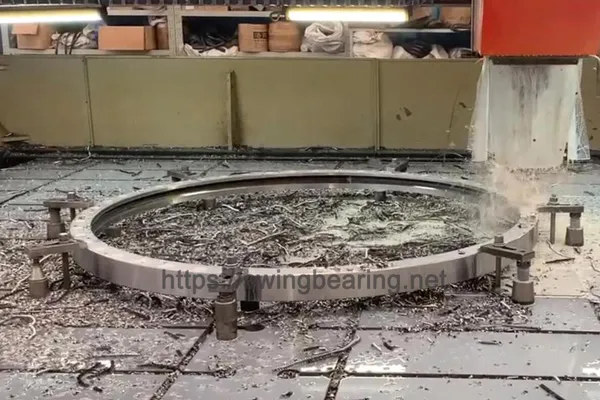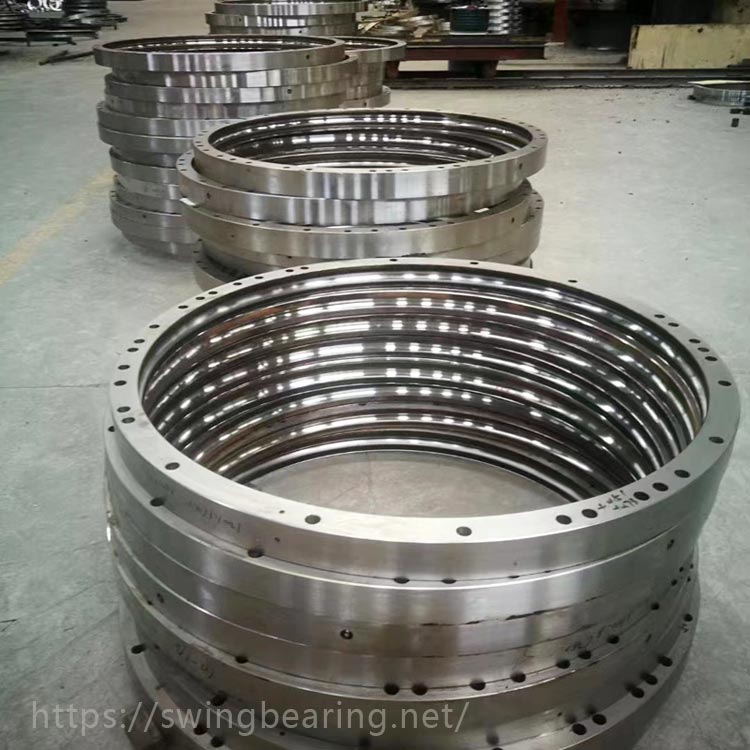
The swing bearing of an excavator is a crucial component that allows for the smooth rotation of the machine’s upper structure. For the Caterpillar CAT 390D excavator, the swing bearing part number 227-6099 is designed to endure significant stress and impact loads. This guide will explore the intricate details of the Caterpillar CAT 390D swing bearing, focusing on its specifications, processing, operational stresses, and repair methodologies. This detailed overview aims to provide both technical insights and practical advice for maintaining and repairing these essential components.
The Caterpillar CAT 390D swing bearing (part number 227-6099) is engineered to support the significant weight and operational demands of the excavator. Weighing approximately 1030 lbs, this bearing facilitates the rotation of the excavator’s upper structure, enabling precise maneuverability and efficient operation.
During excavation operations, the swing bearing endures substantial impact loads, particularly from the rotating ring gear. The stress on the bearing increases significantly when the excavator operates on an inclined surface, potentially leading to accelerated wear and damage. Typically, after around 350,000 hours of operation, the teeth of the rotating ring gear may become crushed or broken, necessitating repair or replacement.
Proper preparation is crucial for a successful repair of the swing bearing. The following steps outline the necessary preparation procedures:

Executing the welding process correctly is vital to restore the swing bearing’s functionality and durability. The steps include:
To extend the lifespan of the swing bearing and prevent unexpected failures, regular maintenance is essential:
Regular inspections help identify potential issues early and ensure the continued performance of the swing bearing. Key inspection points include:
Swing bearings are typically made from high-quality alloy steel known for its strength and durability. The steel undergoes rigorous quality checks before being cut into appropriate sizes using precision cutting tools.
The cut pieces are then forged into billets, enhancing the steel’s grain structure and making it more robust. Rough turning shapes the billets into the basic form of the swing bearing, removing excess material and preparing the workpiece for precise machining.
Precision grinding ensures the swing bearings achieve exact dimensions and smooth surface finishes. Heat treatment processes like quenching and tempering enhance the steel’s properties, making it harder and tougher.
After heat treatment, the inner and outer races, rolling elements, and seals are meticulously assembled. Each component is inspected and fitted to ensure optimal performance.
The completed swing bearings undergo rigorous inspection and testing. Any deviations from the specified standards are corrected to ensure each bearing meets the highest quality requirements.
Q: What materials are primarily used in constructing the CAT 390D swing bearing (part number 227-6099)?
A: The CAT 390D swing bearing is primarily constructed from high-quality alloy steel. This material is chosen for its excellent strength, durability, and resistance to wear and fatigue. The alloy steel undergoes various heat treatments to enhance its hardness and toughness, ensuring it can withstand the heavy loads and harsh operating conditions typical of excavation work.
Q: How does the 1030 lbs weight of the CAT 390D swing bearing (part number 227-6099) impact its performance?
A: The substantial weight of 1030 lbs for the CAT 390D swing bearing plays a critical role in its performance. This considerable mass ensures the bearing can support the significant operational loads exerted by the excavator. The weight also contributes to the overall stability and robustness of the bearing, helping to absorb impact loads and reduce vibrations during operation, thereby enhancing the machine’s reliability and longevity.
Q: What are the common indicators of wear in the CAT 390D swing bearing (part number 227-6099)?
A: Common signs of wear in the CAT 390D swing bearing include unusual noises such as grinding or squeaking during operation, visible cracks or deformities in the bearing components, increased play or looseness in the bearing, and leakage of lubricant from the bearing seals. Regular inspections can help detect these signs early, allowing for timely maintenance or replacement to prevent further damage.
Q: What maintenance practices are essential for extending the lifespan of the CAT 390D swing bearing (part number 227-6099)?
A: To extend the lifespan of the CAT 390D swing bearing, it is crucial to adhere to several maintenance practices:
Q: In what ways does the CAT 390D swing bearing (part number 227-6099) improve the efficiency of the excavator?
A: The CAT 390D swing bearing significantly enhances the overall efficiency of the excavator by ensuring smooth and precise rotation of the upper structure. This precision allows for better control and maneuverability of the excavator, improving operational efficiency. The robust construction and durability of the bearing reduce downtime due to maintenance and repairs, ensuring the excavator remains operational for longer periods. Additionally, the efficient load distribution and impact absorption capabilities of the swing bearing contribute to a more stable and reliable performance, ultimately boosting productivity on the job site.
The Caterpillar CAT 390D swing bearing (part number 227-6099) is a critical component that ensures the smooth operation of the excavator’s upper structure. Proper maintenance, regular inspections, and timely repairs are essential for maintaining the performance and longevity of these bearings. By following the guidelines outlined in this comprehensive guide, operators and technicians can effectively manage and maintain their swing bearings, minimizing downtime and maximizing operational efficiency. Whether it’s understanding the machining process or knowing the key inspection points, this guide provides all the necessary information to keep your Caterpillar CAT 390D excavator running smoothly.